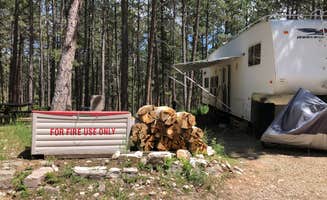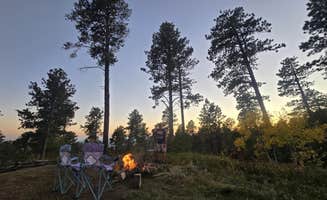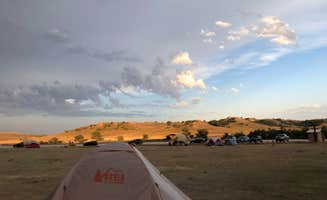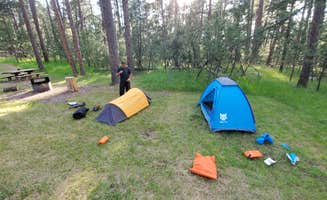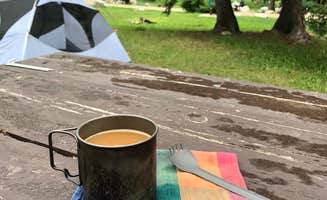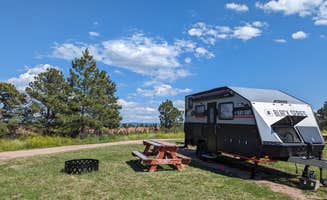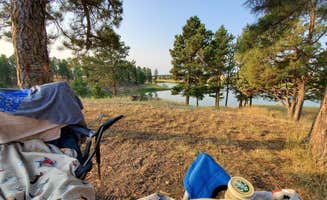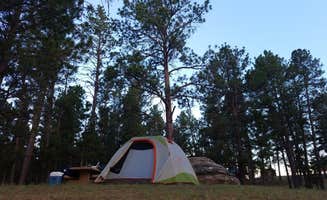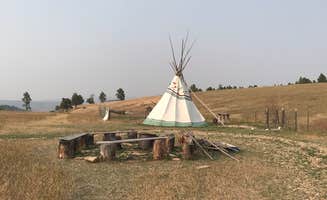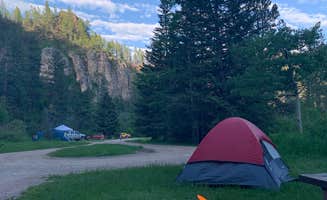Camping options near Sundance, Wyoming sit at elevations between 4,000-6,500 feet in the Black Hills National Forest, with summer temperatures typically ranging from 45-85°F. Most dispersed sites lack amenities but offer more seclusion than developed campgrounds. Cell service weakens significantly in canyon areas and higher elevations, particularly on the northern forest boundaries.
What to do
Hiking from camp: At Cook Lake Campground, the Cliff Swallows Trail starts directly from the camping area. "I was able to start on right next to my site," notes one camper, describing the 3.7-mile loop trail. The lake provides swimming and fishing opportunities without leaving the campground.
Film viewing under stars: The Devils Tower KOA screens "Close Encounters of the Third Kind" outdoors each evening with the monument as backdrop. A visitor writes, "They show 'Close Encounters of the Third Kind' every night, outside with the tower in the background. Very cheesy but very cool."
Wildlife observation: Both dispersed and established sites offer wildlife viewing. At Storm Hill BLM Land, campers report seeing abundant birds from their sites. Another camper notes, "Wildflowers, wildlife, and lots of space! Turn right off the sundance-warren peak road and watch out for cows crossing."
What campers like
Unobstructed monument views: From Devils Tower View Campground, guests enjoy direct sightlines to Devils Tower. "Fantastic view of the tower at sunset!" reports one camper. Another adds, "Amazing little place to camp. Terrific views of the tower, super friendly staff, nice bathrooms."
Creek access: Campers appreciate water features like the stream at Spearfish City Campground. "The stream running through the campground is crystal clear and the kids loved playing in it," notes one reviewer. Another mentioned, "We stayed in July and the city of Spearfish had activities in the park about 1/4 mile away every evening."
Forested privacy: Many campers highlight the pine forest settings. At Reuter Campground, visitors note, "We were noticing all the campgrounds around seemed to NOT have trees. We are tent camping, so shade is of utmost importance. Reuter did not let us down! Surrounded by big pines and aspen trees." Another camper adds, "Weather was perfect for hammock camping which all the trees made easily possible."
What you should know
Water access limitations: Many campgrounds restrict water usage or have seasonal availability. One camper at Cook Lake noted, "Take your own water; pump is down by the host site." Another visitor reported, "There is water, but the Forest Service does not really want campers using it."
Road conditions: Access to dispersed sites can be challenging after rain. At Storm Hill BLM Land, a sign warns "Impassable when wet" at the entrance. "The dirt road is very ugly & might damage your car/trailer. Come early to get the best spot!" advises one camper.
Seasonal closures: Most Forest Service campgrounds close by early September. "We arrived the day before they stopped taking reservations. We were confused as to what was reserved and what wasn't. No host on site, no payment envelopes," reported a Reuter Campground visitor in mid-September when operations were changing to off-season mode.
Tips for camping with families
Look for shaded campsites: Summer temperatures frequently reach the mid-80s. A camper at Reuter Campground noted, "All the spots were shaded and spread far enough to give you some privacy. We had some visitors the morning we were packing to leave 🐄🐄🐄🐄."
Consider campground activities: Some locations offer on-site recreation. Mountain View RV Park & Campground provides "a pool, miniature golf, dog runs, laundry, an honest to goodness General Store and a cafe. The facility also offers hayrides."
Check for free firewood: A unique feature at Belle Fourche Campground is complimentary firewood. "There are fire rings and free firewood," reports one visitor. Another notes, "Clean bathrooms, meticulously maintained campground. $10 per night. Heaven on Earth."
Tips from RVers
Account for off-season changes: Services and facilities may be limited in spring and fall. At Reuter Campground, one RVer noted, "No running water because it's technically the off season...but no complaints from us!"
Use established directions: GPS directions can be unreliable. For Cook Lake Campground, a visitor warned, "If you drive from Sundance, follow USFS directions; Google maps tried to direct me up a dead end road. Road from Aladdin side is better and easier."
Check for dump stations: While many campgrounds lack sewer hookups, alternatives exist. One Reuter Campground visitor shared, "Sundance rest area has free water and dump station," noting it's only "5 minutes from Sundance."


